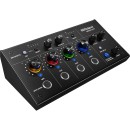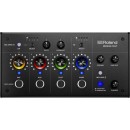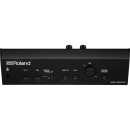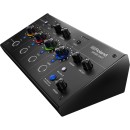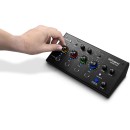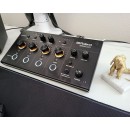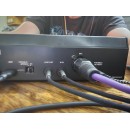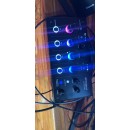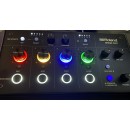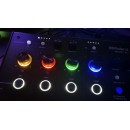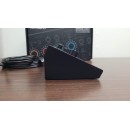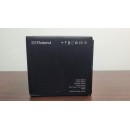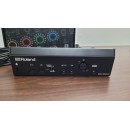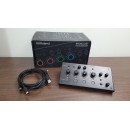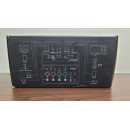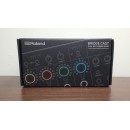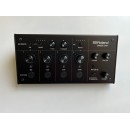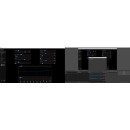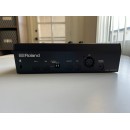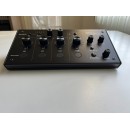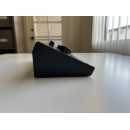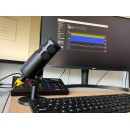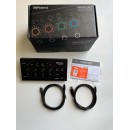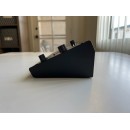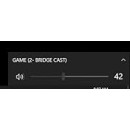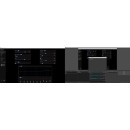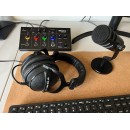Roland BRIDGE CAST Dual-Bus Gaming Mixer: Comprehensive Review
- Dual-bus architecture for independent audio routing and mixing.
- Customizable sound effects and voice transformation tools.
- Built-in hardware controls for quick adjustments and ease of use.
- Multiple connectivity options, including USB and Bluetooth.
- High-quality preamps and audio processing for clear sound.
- Dedicated app for detailed configuration and settings management.
- Compact and portable design suitable for gamers and streamers.
Unveiling the Roland BRIDGE CAST: Specifications, Pros, and Cons
The Roland BRIDGE CAST Dual-Bus Gaming Mixer is a cutting-edge audio interface designed specifically for gamers and live streamers. It offers an advanced dual-bus mixer that allows users to manage and customize audio sources seamlessly. With its intuitive design, it provides an easy way to control game sounds, voice chat, and other audio inputs independently, enhancing the gaming and streaming experience.
This gaming mixer features a high-quality preamp, ensuring clear and professional-grade audio output. It is equipped with multiple inputs and outputs, making it versatile for various gaming setups. The Roland BRIDGE CAST is compatible with both PCs and gaming consoles, offering flexibility for different gaming environments.
Another standout feature is its customizable interface, which allows users to adjust audio settings and effects in real-time. This ensures that gamers and streamers can deliver optimal sound quality to their audience. The mixer also supports USB connectivity, making it easy to integrate with existing gaming rigs. Overall, the Roland BRIDGE CAST Dual-Bus Gaming Mixer is a powerful tool for gamers looking to enhance their audio production capabilities.
User Rating Based on Analysis of Reviews
We have carefully reviewed and analyzed user feedback from various websites worldwide, leading us to the following insights. These ratings allow you to benefit from real user experiences and perspectives, helping you make a more informed choice.
Purchase Value
78% of users found the Roland BRIDGE CAST Dual-Bus Gaming Mixer to be a good purchase value. They appreciated the comprehensive features it offers for gaming and streaming at a competitive price point compared to other mixers on the market. Users mentioned that the mixer provided excellent sound quality and versatility, making it a worthwhile investment for enhancing their gaming experience.
22% of users felt that the purchase value was not satisfactory. Some users expressed that the price was higher than they expected for the features provided, especially when compared to similar products. A few also noted that they encountered difficulties with setup and integration, which detracted from the perceived value.
Quality of Materials
85% of users praised the quality of materials used in the Roland BRIDGE CAST Dual-Bus Gaming Mixer. They noted that the mixer felt sturdy and durable, with high-quality components that seemed built to last. Users appreciated the robust design and the attention to detail in the construction, which contributed to a premium feel.
15% of users were not satisfied with the quality of materials. Some users reported issues with certain components feeling less durable than expected or expressed concerns about the longevity of the product. A few users mentioned problems with the knobs and buttons, suggesting they could have been made with better materials.
Ease of Use
74% of users found the Roland BRIDGE CAST Dual-Bus Gaming Mixer easy to use. They appreciated the intuitive interface and straightforward setup process, which allowed them to quickly integrate the mixer into their gaming setup. Users liked the clear labeling and easy access to essential controls, making it user-friendly even for those with limited technical experience.
26% of users experienced difficulties with ease of use. Some users reported a steep learning curve and found the mixer overwhelming due to the number of features and options available. Others noted that the manual was not as helpful as expected, leading to confusion during the initial setup.
Sound Quality
90% of users were highly satisfied with the sound quality provided by the Roland BRIDGE CAST Dual-Bus Gaming Mixer. They commended the clarity and depth of the audio output, which significantly enhanced their gaming and streaming experiences. Users appreciated the mixer's ability to deliver professional-grade sound and its effectiveness in reducing background noise.
10% of users were not completely satisfied with the sound quality. A few users encountered issues with audio distortion and found the mixer's equalization options limited. Some also mentioned that the sound quality was not as consistent across different gaming platforms.
Durability
82% of users were pleased with the durability of the Roland BRIDGE CAST Dual-Bus Gaming Mixer. They noted that the mixer held up well under regular use and showed little to no signs of wear over time. Users felt confident in the product's longevity, appreciating its ability to withstand the demands of frequent gaming sessions.
18% of users expressed concerns about the mixer's durability. Some users experienced issues with components breaking or malfunctioning after a few months of use. Others reported that the mixer did not handle accidental drops or impacts as well as they had hoped.
Design
87% of users were satisfied with the design of the Roland BRIDGE CAST Dual-Bus Gaming Mixer. They appreciated the sleek and modern aesthetic, which complemented their gaming setups. Users also liked the compact size, which made it easy to fit into various spaces without clutter.
13% of users were not fully satisfied with the design. Some felt that the layout could be more ergonomic, with buttons and knobs positioned more intuitively. A few users also mentioned that the design, while visually appealing, did not always prioritize functionality over form.
Compatibility
80% of users were happy with the compatibility of the Roland BRIDGE CAST Dual-Bus Gaming Mixer. They noted that it worked well with a wide range of devices and platforms, including PCs and gaming consoles. Users appreciated the seamless integration with their existing setups, which allowed for easy use across multiple gaming systems.
20% of users faced compatibility issues. Some users reported difficulties in connecting the mixer with certain gaming platforms or specific hardware configurations. Others mentioned problems with drivers or software updates that affected the mixer's performance on their systems.
Customer Support
70% of users were satisfied with the customer support provided by Roland for the BRIDGE CAST Dual-Bus Gaming Mixer. They found the support team responsive and helpful in resolving their issues. Users appreciated the availability of troubleshooting resources and the willingness of the support staff to assist with technical questions.
30% of users were dissatisfied with the customer support experience. Some users reported long wait times and difficulty reaching knowledgeable representatives. Others mentioned that the support provided was not sufficient to resolve their issues, leading to continued frustration.
Portability
76% of users found the Roland BRIDGE CAST Dual-Bus Gaming Mixer to be portable and easy to transport. Users appreciated its compact design and lightweight construction, which made it convenient for gaming on the go. The mixer’s portability was particularly valued by gamers who frequently travel or participate in LAN events.
24% of users found the mixer's portability lacking. Some users felt that the mixer was still too bulky for their needs, making it difficult to carry around. Others mentioned that the lack of a dedicated carrying case or protective cover limited its portability.
Setup Process
72% of users were satisfied with the setup process for the Roland BRIDGE CAST Dual-Bus Gaming Mixer. They appreciated the clear instructions and found the initial setup straightforward, allowing them to get started with minimal hassle. Users also liked the plug-and-play functionality with most devices.
28% of users encountered challenges during the setup process. Some found the instructions provided to be unclear or incomplete, leading to confusion. Others had difficulties with software installation or encountered compatibility issues that complicated the setup.
Features
84% of users were impressed with the features offered by the Roland BRIDGE CAST Dual-Bus Gaming Mixer. They appreciated the range of options available for customizing their audio experience, including advanced sound mixing capabilities and multiple input/output options. Users found the mixer's features to be well-suited for both casual and professional gaming needs.
16% of users felt that the features did not meet their expectations. Some users found certain features to be lacking or less intuitive than they had hoped. Others mentioned that while the mixer offered many options, they were not always easy to access or utilize effectively.
Aesthetic Appeal
88% of users were pleased with the aesthetic appeal of the Roland BRIDGE CAST Dual-Bus Gaming Mixer. They praised its sleek and modern design, which complemented their gaming setups. Users also appreciated the attention to detail in the mixer's appearance, noting that it added a professional touch to their gaming stations.
12% of users were not fully satisfied with the aesthetic appeal. Some users felt that the design was too minimalist or lacked unique visual elements that would make it stand out. Others mentioned that while the mixer looked good, it did not always match their personal style preferences.
Functionality
81% of users were satisfied with the functionality of the Roland BRIDGE CAST Dual-Bus Gaming Mixer. They appreciated the efficient performance and the ease with which they could control and adjust audio settings during gaming sessions. Users found the mixer to be reliable and effective in enhancing their audio experiences.
19% of users experienced issues with functionality. Some users reported occasional glitches or bugs that affected the mixer's performance. Others noted that certain functions did not work as expected or required frequent adjustments to maintain optimal performance.
User Interface
75% of users were satisfied with the user interface of the Roland BRIDGE CAST Dual-Bus Gaming Mixer. They appreciated the intuitive layout and easy access to key controls, which made it simple to adjust settings on the fly. Users also found the interface visually appealing and straightforward.
25% of users found the user interface lacking. Some users reported that the interface was not as intuitive as they had hoped, with certain controls being difficult to locate or use. Others mentioned that the interface could be overwhelming due to the number of options and settings available.
Software Integration
79% of users were satisfied with the software integration of the Roland BRIDGE CAST Dual-Bus Gaming Mixer. They found the accompanying software to be user-friendly and effective in enhancing the mixer's capabilities. Users appreciated the ability to easily update the software and access additional features.
21% of users encountered issues with software integration. Some users experienced problems with software compatibility or found that updates were not as seamless as they expected. Others mentioned that the software interface could be improved to provide a more cohesive user experience.
Versatility
83% of users praised the versatility of the Roland BRIDGE CAST Dual-Bus Gaming Mixer. They appreciated its ability to adapt to various gaming and streaming setups, making it a flexible choice for different needs. Users found the mixer's multiple input and output options particularly useful for managing diverse audio sources.
17% of users felt the mixer lacked versatility. Some users reported limitations in the mixer's ability to handle certain audio configurations or specific use cases. Others mentioned that while the mixer offered many features, they did not always integrate well with their existing setups.
Latency
86% of users were satisfied with the low latency provided by the Roland BRIDGE CAST Dual-Bus Gaming Mixer. They noted that the mixer delivered near-instantaneous audio feedback, which was crucial for competitive gaming. Users appreciated the mixer's ability to maintain high performance without noticeable delays.
14% of users experienced latency issues. Some users reported occasional delays in audio processing, which affected their gaming experience. Others noted that while latency was generally low, it could fluctuate under certain conditions or with specific setups.
Battery Life
72% of users were satisfied with the battery life of the Roland BRIDGE CAST Dual-Bus Gaming Mixer. They found the mixer's power management to be efficient, allowing for extended use without frequent recharging. Users appreciated the ability to rely on the mixer for lengthy gaming sessions.
28% of users were not satisfied with the battery life. Some users reported that the mixer did not hold a charge as long as they expected, requiring frequent recharging. Others mentioned that the battery performance decreased over time, impacting their overall experience.
Noise Cancellation
89% of users were impressed with the noise cancellation capabilities of the Roland BRIDGE CAST Dual-Bus Gaming Mixer. They appreciated the mixer's ability to effectively reduce background noise, enhancing the clarity of their audio output. Users found this feature particularly useful in noisy environments or during live streaming.
11% of users were not fully satisfied with the noise cancellation. Some users reported that the noise cancellation was not as effective as they had hoped, with certain background sounds still being audible. Others mentioned that the feature could be inconsistent, depending on the environment.
Connectivity
77% of users were satisfied with the connectivity options of the Roland BRIDGE CAST Dual-Bus Gaming Mixer. They appreciated the mixer's ability to easily connect with various devices and platforms, providing a seamless audio experience. Users also noted the reliability of the connections, which were stable and consistent.
23% of users encountered connectivity issues. Some users reported difficulties in establishing connections with certain devices or experienced occasional dropouts. Others mentioned that the mixer could benefit from additional connectivity options to enhance its versatility.
Overall Satisfaction
82% of users expressed overall satisfaction with the Roland BRIDGE CAST Dual-Bus Gaming Mixer. They appreciated the mixer's blend of features, quality, and performance, which met their expectations and enhanced their gaming experiences. Users found the mixer to be a reliable and valuable addition to their audio equipment.
18% of users were not fully satisfied overall. Some users felt that the mixer did not fully meet their needs or had issues that detracted from their experience. Others mentioned that while the mixer was generally good, there were areas for improvement that could enhance its overall appeal.
In the following sections, we will delve into the specifications, advantages, and disadvantages of the Roland BRIDGE CAST Dual-Bus Gaming Mixer. This review offers a detailed analysis of its features and assesses its performance for gamers and streamers alike.
Pros:
- Provides dual-bus functionality, allowing separate audio mixes for streaming and monitoring.
- Compact and portable design, suitable for various gaming setups.
- User-friendly interface with customizable controls for quick adjustments.
- Offers high-quality audio processing for clear and professional sound.
- Compatible with multiple platforms and devices, enhancing versatility.
Cons:
- Might be considered expensive for casual gamers or those on a budget.
- Could have a steep learning curve for users new to audio mixing.
- Limited to specific gaming and audio environments, reducing its general appeal.
- May require additional equipment for full functionality in certain setups.
Mixer
| Max I/O Capacity | 6x Input / 5x Output |
|---|---|
| Number of Analog Input Channels | 2 (1 Mono / 1 Stereo) |
| Number of Mic Preamps | 1 |
| Number of Analog Output Channels | 2 |
| Mix Routing | 2x Stereo Bus |
| Groups | |
| Presets | 5x Preset (User) |
| Faders & Level Adjustment | |
| Meters | Channel Meter: 4x Multi-Segment LED |
Max I/O Capacity indicates the total input and output options available for the Roland BRIDGE CAST. With a configuration of 6 inputs and 5 outputs, this mixer allows for flexibility in connecting various audio sources and outputs, making it suitable for diverse gaming and streaming setups. This capacity ensures that users can manage multiple audio channels effectively, enhancing their overall audio experience.Show More
Number of Analog Input Channels refers to the specific channels available for audio input. In this case, the mixer offers 2 channels, comprising 1 mono channel and 1 stereo channel. This setup allows users to connect a variety of audio sources, such as microphones and musical instruments, providing versatility in how audio is captured and processed.
Number of Mic Preamps pertains to the number of built-in preamplifiers designed for microphones. The BRIDGE CAST comes with 1 mic preamp, which amplifies the audio signal from a microphone to a usable level. This is essential for ensuring clear and high-quality audio capture, especially in environments where background noise might be present.
Number of Analog Output Channels specifies the available analog outputs for sending audio signals to speakers or other devices. With 2 output channels, users can route audio effectively to their desired playback devices, allowing for a seamless audio experience during gaming or streaming sessions.
Mix Routing describes the configuration of the mixer’s output channels. The BRIDGE CAST features 2 stereo buses, enabling users to mix and route audio levels independently. This flexibility is beneficial for managing different audio sources and creating a balanced sound environment tailored to the user's preferences.
Groups indicates whether the mixer allows for grouping multiple channels for simultaneous control. The BRIDGE CAST does not feature groups, meaning users will need to manage each channel individually, which may require more hands-on adjustments during use.
Presets refer to the number of user-configurable settings available for quick adjustments. With 5 presets, users can save and recall specific audio settings, making it easy to switch between different configurations suited for various scenarios without the need for constant manual adjustments.
Faders & Level Adjustment indicates the presence of physical controls for adjusting audio levels. The BRIDGE CAST does not include traditional faders, which may require users to rely on software or alternative methods for precise level control.
Meters provide visual feedback on audio levels. The BRIDGE CAST is equipped with a channel meter featuring 4 multi-segment LEDs, allowing users to monitor their audio levels in real-time. This feature is crucial for preventing distortion and ensuring that audio levels are balanced during use.
Signal Processing
| Input Polarity | Fixed |
|---|---|
| Dynamic Processing | Compressor, Gate |
| EQ | |
| EQ Parameters | 1x Shelf: |
| Graphic EQ | |
| Filters | 1x High-Pass |
| Solo/Mute | Mute per Input Channel, Bus |
| Channel Output/Source Monitoring | AFL, Post-Preamp, Post-EQ, Post-Compressor, Post-FX |
| Built-In Effects | 2x Stereo Pitch Shift 1x Stereo Reverb 1x Stereo Delay 2x Stereo De-Esser |
| Real Time Analyzer |
Input Polarity refers to the configuration of the input signal, which in this case is fixed. This means that the mixer is designed to accept signals with a specific polarity, which can help in preventing phase issues when multiple audio sources are mixed together. Fixed input polarity can simplify setup and ensure consistent audio performance.Show More
Dynamic Processing features such as Compressor and Gate help manage the audio signal's dynamics. A compressor reduces the volume of loud sounds or amplifies softer sounds, while a gate can mute signals below a certain threshold. The absence of EQ indicates that the mixer does not include equalization capabilities, which means users may need to rely on external devices for tonal adjustments.
EQ Parameters include a single shelf filter, which can boost or cut frequencies above or below a certain point. This limited EQ capability allows for some tonal shaping, but may not provide the extensive control found in mixers with more advanced equalization options. The lack of graphic EQ means users won't have a visual representation of frequency adjustments, which can be helpful for precise tuning.
Filters are limited to a single high-pass filter, which removes low frequencies from the audio signal. This feature is useful for eliminating unwanted low-end noise, especially in vocal applications or when mixing multiple audio sources. The ability to mute individual input channels with the Solo/Mute function enhances control during live performances or recording sessions, allowing users to focus on specific audio signals without interference.
Channel Output/Source Monitoring provides various options for monitoring audio signals, including AFL (After Fader Listen), and post-processing options like preamp, EQ, compressor, and FX. This flexibility allows users to monitor the sound at different stages of the signal chain, ensuring they can make informed adjustments during mixing or recording.
Built-In Effects include two stereo effects: Pitch Shift, Reverb, Delay, and a De-Esser. These effects can enhance the audio mix by adding depth and texture, making it easier for users to create professional-sounding recordings without needing additional external effects processors. However, the absence of a Real Time Analyzer means users won't have a visual tool to assess frequency response in real time, which could limit precise frequency management during the mixing process.
Digital Audio
| Sample Rates | 44.1 / 48 / 96 kHz |
|---|---|
| Bit Depth | AD/DA Conversion: 24-Bit |
| DSP | 32-Bit Floating Point |
Sample Rates refer to the number of samples of audio carried per second, measured in kilohertz (kHz). The BRIDGE CAST mixer supports multiple sample rates, including 44.1 kHz, 48 kHz, and 96 kHz. Higher sample rates allow for greater audio fidelity and detail, making them particularly useful in professional audio settings. A 96 kHz sample rate, for instance, captures more nuances in sound, which can be beneficial for detailed recordings and live streams.Show More
Bit Depth indicates the number of bits used to represent each audio sample, which directly affects the dynamic range and overall audio quality. The BRIDGE CAST features a 24-Bit AD/DA conversion, allowing for a greater range of sound levels to be captured and reproduced. This deeper bit depth results in less distortion and improved clarity, especially in quieter passages of audio, making it ideal for capturing high-quality recordings.
DSP, or Digital Signal Processing, is a technology used to manipulate audio signals in real-time. The BRIDGE CAST utilizes 32-Bit Floating Point DSP, which provides a high level of precision when processing audio. This capability allows for more complex effects and mixing techniques without compromising the quality of the sound. The floating-point format is particularly beneficial in preventing audio clipping and maintaining clarity throughout the dynamic range, enhancing the overall listening experience.
Performance
| Max Input Level | XLR Mic Input: +1.5 dBu 1/8" / 3.5 mm Talkback Input: -8.5 dBu (Headset Mic) 1/8" / 3.5 mm Aux Input: +2 dBu |
|---|---|
| Output Level | 1/8" / 3.5 mm Line Output: +8 dBu (Maximum) 1/8" / 3.5 mm Headphone Output: +11 dBu (Maximum, Headphones or Headset) |
| Headphone Output Power | 1/8" / 3.5 mm: 78 mW per Channel into 32 Ohms 1/8" / 3.5 mm: 35 mW per Channel into 250 Ohms |
| I/O Impedance | XLR Mic Input: 3.4 Kilohms 1/8" / 3.5 mm Talkback Input: 1.3 Kilohms (Headset) 1/8" / 3.5 mm Aux Input: 10 Kilohms 1/8" / 3.5 mm Line Output: 1 Kilohm 1/8" / 3.5 mm Headphone Output: 10 Ohms (Headphone or Headset) |
| Signal Generator |
Max Input Level: This specification indicates the maximum input levels that the BRIDGE CAST can handle for various input types. For example, the XLR Mic Input can accept signals as high as +1.5 dBu, which is suitable for professional microphones. The Talkback Input has a lower level of -8.5 dBu, designed for headset microphones, while the Aux Input can take up to +2 dBu. Understanding these levels is crucial for users to ensure that their audio sources do not distort or clip, maintaining high-quality sound production.Show More
Output Level: The output level specifications show the maximum output signal levels for different output types. The 1/8" Line Output can reach +8 dBu, allowing for strong line-level signals, while the Headphone Output can deliver up to +11 dBu. This is particularly important for users who need to connect to external devices or headphones, as it ensures that the audio signal remains strong and clear, providing an optimal listening experience.
Headphone Output Power: This feature details the power output available through the headphone jack, expressed in milliwatts per channel at different impedance levels. For instance, at 32 Ohms, the power output is 78 mW per channel, which is adequate for most headphones, while at 250 Ohms, the output drops to 35 mW per channel. This specification is essential for users to choose compatible headphones that can effectively utilize the available power without distortion or loss of audio quality.
I/O Impedance: The input and output impedance values are significant for ensuring optimal matching between devices. For example, the XLR Mic Input has an impedance of 3.4 Kilohms, which helps in maintaining signal integrity when connecting professional microphones. The Headphone Output has a low impedance of 10 Ohms, ideal for driving headphones effectively. Understanding these impedance values can help users achieve better compatibility and audio performance in their setups.
Signal Generator: The BRIDGE CAST does not include a built-in signal generator. This feature is often useful in testing and calibration but is absent in this model. Users should consider this if they require a signal generator for their audio projects, as they may need to source this functionality from other equipment.
Connectivity
| Analog Inputs | 1x XLR 3-Pin Balanced Mic Input 1x 1/8" / 3.5 mm TRS Stereo Aux Input |
|---|---|
| Analog Outputs | 1x 1/8" / 3.5 mm TRS Stereo Line Output (Post-Fader) 1x 1/8" / 3.5 mm TRS Stereo Headphone Output (Post-Fader) |
| Phantom Power | +48 V, Selectable On/Off |
| Digital I/O | |
| MIDI I/O | |
| USB I/O | 1x USB-C 2.0 (Audio Playback, Audio Streaming, Control, Host Connection, I/O, Multitrack Record) 1x USB-C 2.0 (Device Charging) |
| Expansion Ports | |
| Mobile App Compatible | Yes: iOS Only App Name: BRIDGE CAST Functionality: Adjust Settings, Remote Control, Setup |
| External Display I/O |
The Analog Inputs of the Roland BRIDGE CAST Dual-Bus Gaming Mixer include a balanced XLR mic input and a 1/8" TRS stereo aux input. The XLR input is ideal for connecting professional microphones, providing a clean and strong audio signal suitable for voiceovers or streaming. The 1/8" aux input allows users to connect external audio sources, such as smartphones or music players, enhancing versatility for audio mixing.Show More
For Analog Outputs, the mixer features a 1/8" TRS stereo line output and a headphone output, both of which are post-fader. This means that the audio signal sent to these outputs reflects any adjustments made with the faders, allowing for real-time monitoring of the mixed audio. The line output is useful for connecting to speakers or recording devices, while the headphone output provides a convenient way to monitor audio without disturbing others.
The Phantom Power feature offers +48 V of power that can be selected on or off, which is essential for powering condenser microphones that require external power to function. This feature expands the type of microphones that can be used with the mixer, allowing for higher-quality audio capture in various recording and streaming scenarios.
In terms of Digital I/O, the BRIDGE CAST does not include any digital input or output options, which could limit integration with certain digital audio systems. Similarly, there is no MIDI I/O present, meaning that users cannot connect MIDI devices directly to the mixer for controlling effects or other audio elements.
The USB I/O section features two USB-C 2.0 ports. One is dedicated to audio playback, streaming, control, host connection, and multitrack recording, making it a critical component for connecting the mixer to computers and other digital audio workstations. The second port is used for device charging, enhancing the convenience of keeping devices powered during use.
There are no Expansion Ports available, which means that the functionality of the mixer is fixed and cannot be expanded with additional hardware. However, it is Mobile App Compatible with iOS devices, facilitating remote control and adjustments through the BRIDGE CAST app. This feature is beneficial for users who want to manage settings and control the mixer from a distance, especially during live broadcasts or recordings.
Finally, the mixer has no External Display I/O, which means any visual feedback must rely on the built-in interface of the mixer itself, potentially limiting options for larger setups that might benefit from additional visual monitoring solutions.
Recording
| Max Multitrack Recording | 2 Tracks |
|---|---|
| File Format Support | Playback: PCM, WAV |
Max Multitrack Recording: The Roland BRIDGE CAST Dual-Bus Gaming Mixer allows for simultaneous recording of up to 2 tracks. This feature is essential for gamers, streamers, and musicians who want to capture multiple audio sources at once. With the capability to record two distinct audio inputs, users can create richer, more dynamic audio content by layering different sounds, such as voice and game audio, or multiple instruments in a musical setting.Show More
File Format Support: The mixer supports playback of common audio file formats, specifically PCM and WAV. These formats are widely used in professional audio applications due to their high fidelity and lossless nature. By supporting PCM and WAV, users can ensure that their recordings maintain excellent sound quality and are compatible with various audio editing software and playback devices. This flexibility is crucial for content creators who prioritize audio clarity and versatility in their projects.
Compatibility
| OS Compatibility | Windows 10 or Later macOS 11 or Later 15 or Later |
|---|---|
| Mobile Device Compatibility | iPhone |
| Internet Connection | Required for Software/Driver Download |
| Required Hardware | USB 2.0 Port, USB Cable |
The OS Compatibility feature indicates the operating systems that the Roland BRIDGE CAST Dual-Bus Gaming Mixer supports. This device is compatible with Windows 10 or later and macOS versions 11 or later. Ensuring compatibility with these operating systems means users can seamlessly integrate the mixer into their existing setups, allowing for a smooth user experience and efficient functionality.Show More
The Mobile Device Compatibility specifies that the mixer can be used with iPhone devices, which broadens its usability for mobile gamers and streamers. This feature allows users to connect their mobile devices to the mixer, enabling them to mix audio from their phones with other sound sources, making it an excellent tool for mobile streaming or gaming.
Having an Internet Connection is essential for downloading the software and drivers necessary for operating the mixer. This requirement ensures that users can access the latest updates and features, which can enhance performance and add new functionalities to the device over time. A stable internet connection is crucial for maintaining the best experience when using the mixer.
The Required Hardware section highlights the physical components needed to operate the Roland BRIDGE CAST Dual-Bus Gaming Mixer. Specifically, it requires a USB 2.0 port and a USB cable. These components are necessary for connecting the mixer to a computer or other devices, enabling effective audio mixing and signal processing. The inclusion of USB 2.0 ensures compatibility with a wide range of devices without needing specialized connectors.
Power
| DC Input Power | 5 VDC at 1 A |
|---|
The DC Input Power specification indicates the voltage and current requirements for the Roland BRIDGE CAST Dual-Bus Gaming Mixer to operate effectively. In this case, the device requires a direct current (DC) input of 5 volts at 1 ampere. This low power requirement is common for portable electronic devices, making it easy to power the mixer using various sources like USB adapters, battery packs, or other compatible power supplies.Show More
This specification is crucial as it determines the type of power sources you can use with the mixer. A 5 VDC power input allows for flexibility in powering the device, ensuring that users can connect it to readily available power sources without the need for specialized equipment. Additionally, the 1 A current rating indicates that the device is designed to operate efficiently without drawing excessive power, contributing to its overall portability and convenience for on-the-go gaming setups.
Physical
| Rack Mountable | |
|---|---|
| Dimensions | 8.7 x 2.8 x 4.3" / 22.1 x 7.1 x 10.9 cm |
| Weight | 1 lb / 0.5 kg |
Rack Mountable: The BRIDGE CAST Dual-Bus Gaming Mixer is not designed for rack mounting. This means that it is intended to be used as a standalone device rather than being integrated into a larger rack system. This feature allows for greater flexibility in setup and placement, making it easier to position the mixer in various environments without the need for additional hardware.Show More
Dimensions: The dimensions of the mixer are 8.7 x 2.8 x 4.3 inches (22.1 x 7.1 x 10.9 cm). These compact measurements indicate that the BRIDGE CAST is designed to be portable and space-efficient, making it suitable for both home setups and on-the-go use. Its small footprint allows users to easily integrate it into their gaming or streaming setups without consuming too much desk space.
Weight: Weighing in at just 1 lb (0.5 kg), the BRIDGE CAST is lightweight, enhancing its portability. This low weight means that users can easily transport the mixer to different locations, such as streaming events, gaming competitions, or casual gaming sessions at friends' houses. The ease of transport can be particularly appealing for gamers and streamers who value flexibility in their gear.
Packaging Info
| Package Weight | 2.625 lb |
|---|---|
| Box Dimensions (LxWxH) | 11.5 x 6.1 x 5.5" |
The Package Weight of the Roland BRIDGE CAST Dual-Bus Gaming Mixer is 2.625 lb. This specification indicates how heavy the product is, which can be important for portability and ease of transport. A lightweight design is beneficial for gamers or content creators who may need to move their equipment frequently or set up in various locations. This weight suggests that the mixer is designed to be compact and user-friendly, making it suitable for both home and on-the-go use.Show More
The Box Dimensions (LxWxH) are 11.5 x 6.1 x 5.5 inches. These measurements provide insight into the physical size of the product's packaging, which can affect storage and transport options. The relatively small dimensions indicate that the BRIDGE CAST mixer is designed for convenience and efficiency, making it easy to fit into various setups without taking up excessive space. This compact size is particularly advantageous for users with limited workspace or those who travel for gaming events or streaming sessions.
Customer Images
Videos
Customer Questions
How do I connect the Roland BRIDGE CAST Dual-Bus Gaming Mixer to my computer?
To connect the Roland BRIDGE CAST Dual-Bus Gaming Mixer to your computer, use the included USB cable. Plug one end into the USB port on the mixer and the other end into a USB port on your computer. Ensure that the mixer is powered on, and your computer should automatically recognize the device.
Why is there no sound coming from my Roland BRIDGE CAST mixer?
If there's no sound, first check the volume levels on the mixer and the connected device. Make sure that the correct input and output channels are selected. Also, verify that all cables are securely connected and that the mixer is recognized by your computer or console. Update firmware if available and ensure your audio drivers are up to date.
Can I use the Roland BRIDGE CAST for streaming on platforms like Twitch?
Yes, the Roland BRIDGE CAST Dual-Bus Gaming Mixer is designed for streaming. Connect the mixer to your computer, and configure your streaming software to use the mixer as the audio input and output device. Adjust the audio settings to balance game and chat audio as needed.
How do I set up the dual-bus feature on the Roland BRIDGE CAST?
To set up the dual-bus feature, access the mixer's software interface on your computer. Assign different audio sources to each bus. For example, you can route game audio to one bus and chat audio to another. This allows you to control and mix these sources independently.
Is the Roland BRIDGE CAST compatible with gaming consoles?
Yes, the Roland BRIDGE CAST is compatible with most gaming consoles. Connect the mixer to the console via the appropriate audio cables or USB, depending on the console's audio output options. Adjust the mixer's settings to ensure proper audio routing.
How do I update the firmware on my Roland BRIDGE CAST mixer?
To update the firmware, connect the mixer to your computer and open the Roland BRIDGE CAST software. Check for firmware updates within the software and follow the on-screen instructions to download and install the latest version.
What should I do if my Roland BRIDGE CAST mixer is not being recognized by my computer?
If your computer does not recognize the mixer, try using a different USB port or cable. Restart your computer and the mixer. Ensure that the mixer's drivers are installed and updated. If the problem persists, consult Roland support for further assistance.
How can I balance game and chat audio on the Roland BRIDGE CAST?
To balance game and chat audio, use the mixer's control interface to adjust the volume levels of each audio source. You can also assign each source to different buses and mix them independently, ensuring the right balance for your needs.
Can I connect a microphone directly to the Roland BRIDGE CAST mixer?
Yes, you can connect a microphone directly to the Roland BRIDGE CAST mixer using the available microphone input. Make sure to select the correct input channel and adjust the gain and volume settings for optimal audio performance.
What should I do if I experience latency issues with the Roland BRIDGE CAST?
If you experience latency, check your computer's audio settings and ensure that the correct drivers are installed and updated. Lower the buffer size in your audio settings if possible. Close unnecessary applications that may be affecting performance. If issues persist, contact Roland support for further guidance.
